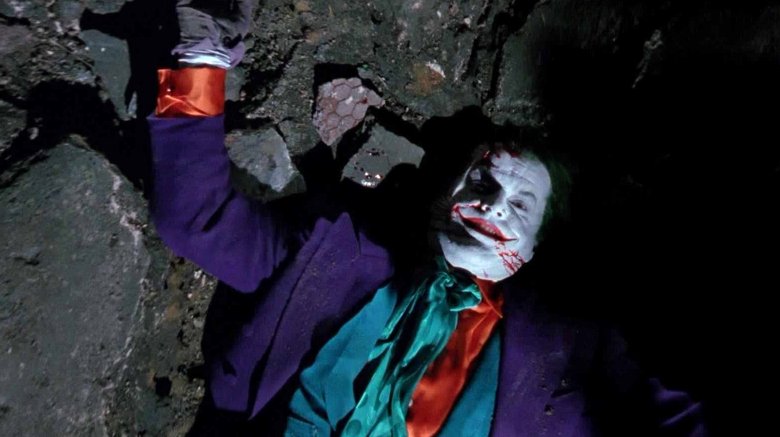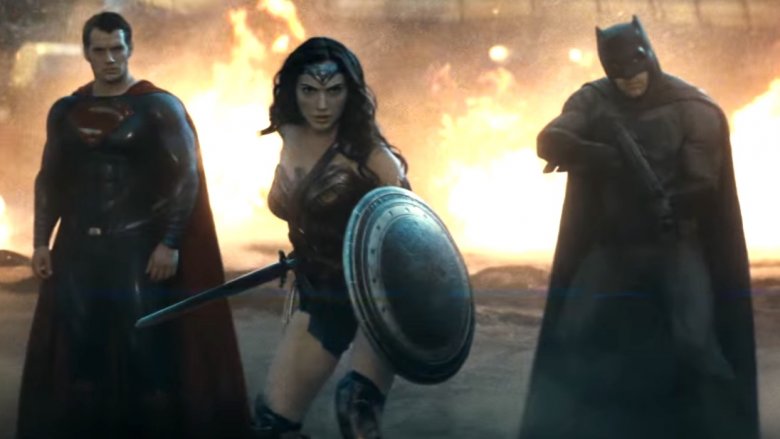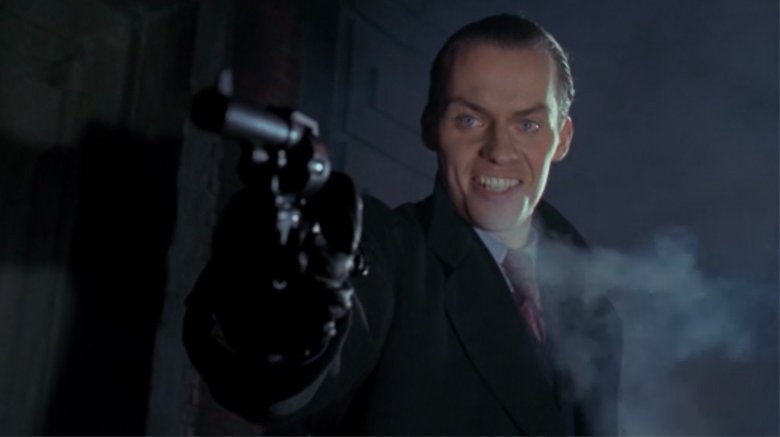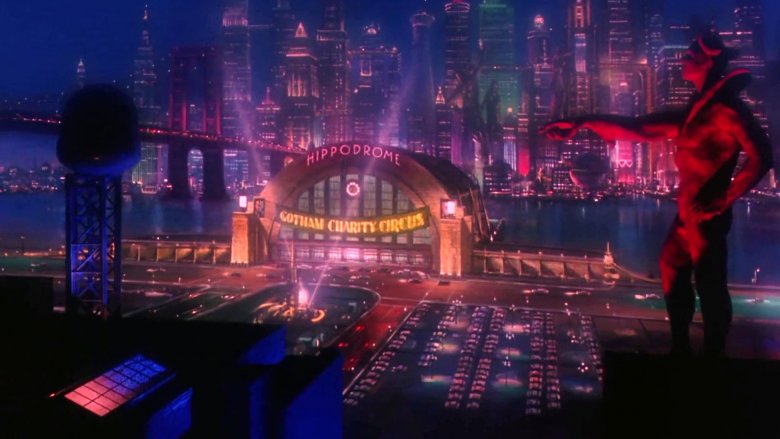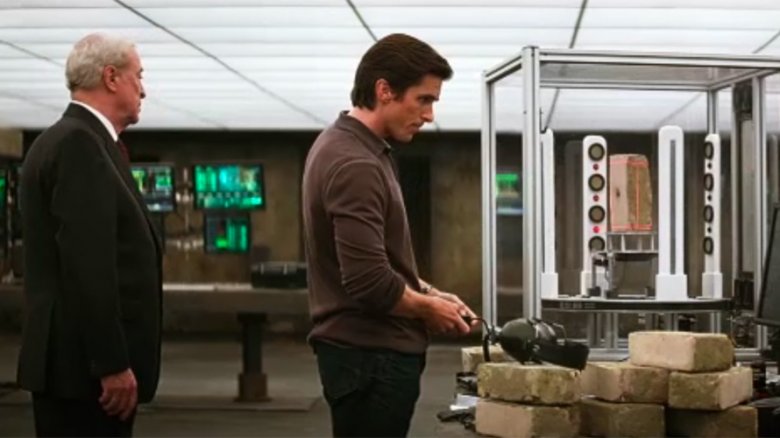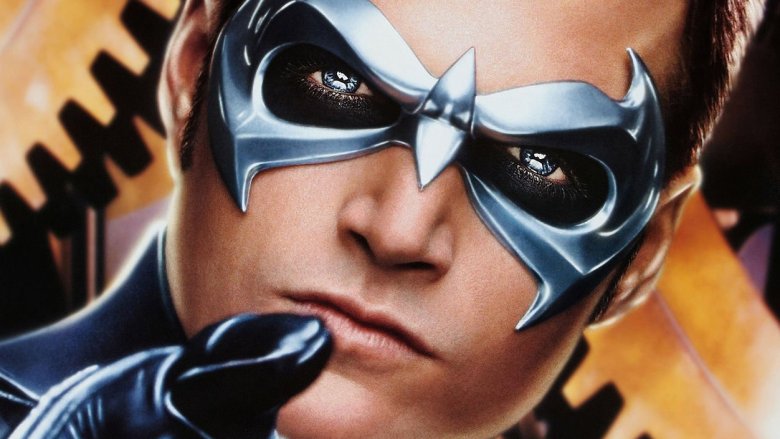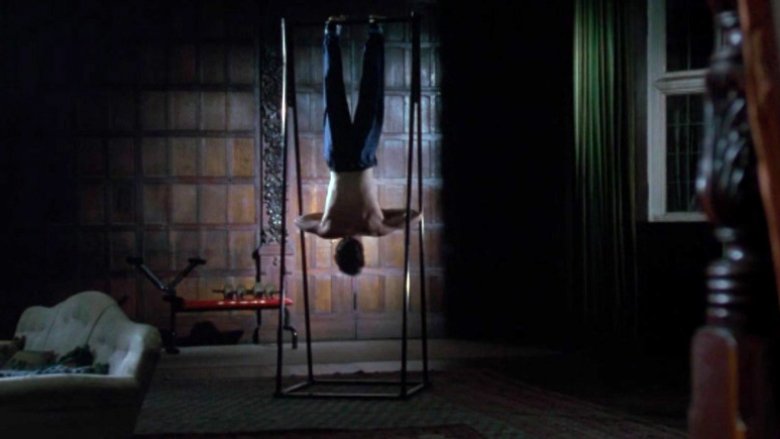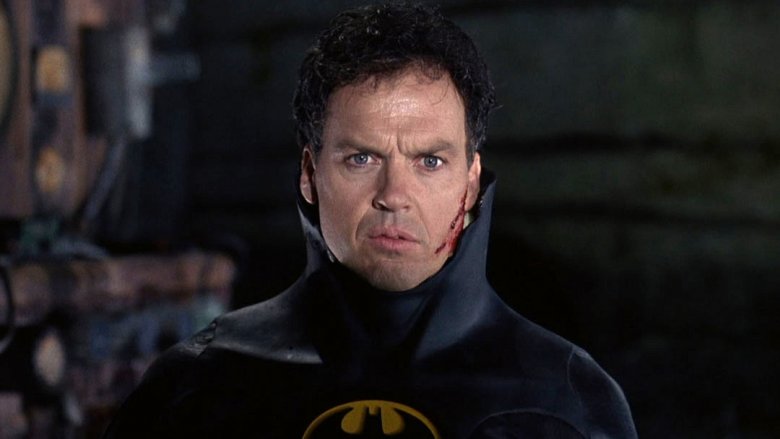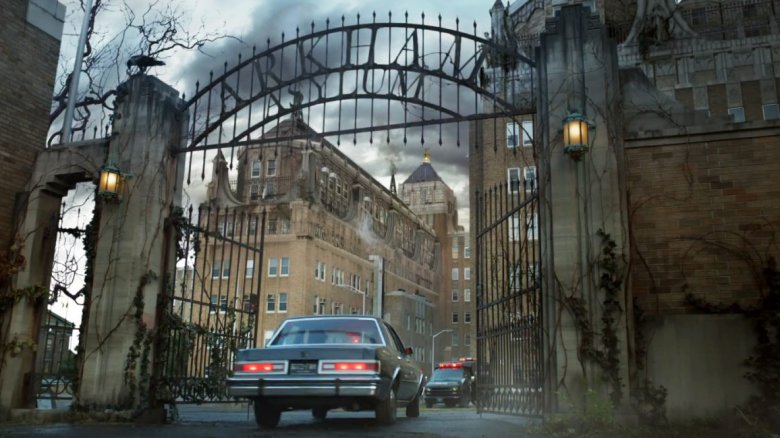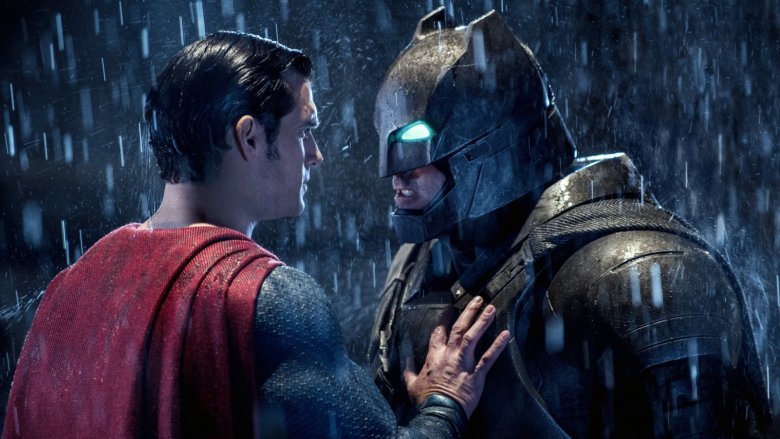Things Movies Always Get Wrong About Batman
Since his debut on the silver screen in 1943, Batman has been featured in more than a dozen theatrical films. He's one of the most popular superheroes ever created, and with that many movies, not to mention the thousands of comic books filmmakers could draw on for inspiration, you'd think they'd have a pretty easy time putting together a version of the Caped Crusader that was true to his roots.
And yet, no matter how good the movies are, they always seem to mess something up. Whether it's his methodology for fighting crime, his relationships to other heroes, or even the appearance of Gotham City itself, something seems a little bit off every time the Dark Knight hits the theater. With that in mind, here are the things that movies always seem to get wrong about Batman.
Killin' villains
The biggest sticking point for Batman fans when it comes to his portrayal in film is that in the comics, there's one diehard, steadfast rule that he abides by when it comes to dealing with his villains: Batman doesn't kill. There are a few exceptions, including the earliest stories that were more about ripping off the gun-toting pulp vigilante called the Shadow than making Batman his own character, but it's been a stated rule since 1941 — less than two years into his 80-year run.
In the movies, Bruce Wayne might actually be the most prolific murderer that Gotham City has ever seen, and that's saying something. Tim Burton's 1989 Batman film, for instance, finds Batman blowing up a chemical factory that's full of the Joker's henchmen, and even casually tossing one guy to his death using a pro wrestling-style headscissor takedown in the climactic journey up to the bell tower. Batman v Superman is full of scenes showing Batman running dudes over and crushing them to death with his rocket car. Even Christopher Nolan's Dark Knight trilogy gets into some grey areas with the whole "I'm not going to kill you... but I don't have to save you" thing when he leaves Ra's al-Ghul to die in a train crash.
The weirdest thing about this one, though? Batman's even a killer — albeit by accident — in the otherwise campy 1966 film. When the Penguin sneaks a bunch of goons into the Batcave by temporarily dehydrating them into a powdered form for easy transportation, they wind up being a lot more unstable when they're reconstituted with radioactive water from Batman's personal nuclear reactor. As a result, a single punch causes them to blink out of existence, and while that's a lot goofier than, say, blowing up a nameless henchman with a time bomb like in Batman Returns, it still counts.
Guns & Ammo
Even if you're willing to relax the rules about Batman killing people, the movies still tend to take things a step too far. Throwing a guy off a bell tower or punching the Penguin into a sewer full of toxic waste is one thing, but Batman never, ever uses guns. It's kind of his thing.
The reasons here are pretty obvious, especially since the movies insist on showing us Batman's origin story over and over and over again. Since his parents were murdered by a man with a gun, Batman wound up with an aversion to firearms, and prefers to use weapons like bat-shaped metal boomerangs. In the movies, however, that dude is armed to the teeth.
Occasionally, Movie Batman will just straight up pack heat, like in Batman v Superman, where he stands around with a useless rifle while Superman and Wonder Woman trade punches with Doomsday. Mostly, however, this manifests as a truly ridiculous amount of high-caliber armaments included in his vehicles. Batman '89 and Batman v Superman both feature Batmobiles with hood-mounted machine guns that are used to reduce crooks to a fine red mist. The Burton film's Batwing also features two M61 Vulcan cannons and missiles, although Batman seems to be completely unable to hit anything with them. Even the motorcycle-esque "Batpod" of The Dark Knight has massive cannons, and while those are used to blow up unoccupied vehicles rather than people, Gotham City's car owners will confirm that's still a jerk move on Batman's part.
'It was me all along!'
Until they were the source of sprawling, 20-film franchises that were the most popular things in Hollywood, superheroes were generally considered to be a subgenre of action movies, subject to all the tropes and traditions that you'd expect. That's where you'll find a lot of the disconnect between Batman's comic book roots and his movie incarnations: the tension between two genres that seem like they'd complement each other, but have some very key differences.
The relationship between an action movie hero and their villain, for instance, is usually operating on some kind of personal connection. Take classics like Die Hard, Commando, or even a more recent hit like John Wick. There's a very personal reason for the good guy to be mowing down the baddies that goes way beyond just the fact that they're trying to blow up Nakatomi Tower/murdering former members of an elite special forces team/just generally being lousy dudes who should've been nicer to that dog. In the 1989 Batman film, that leads to the decision of having the Joker revealed to be the criminal who killed Bruce Wayne's parents.
In the language of action movies, that ties up everything with a nice, neat bow, but for a superhero, it doesn't really work. Batman doesn't need a specific connection with a bad guy to go fight crime, he's a crimefighter. It's what he does. Putting that connection in there with one of his major villains doesn't make for a neater story, it just makes Batman seem like a weirdo with too much money who's only out for his own revenge, with any additional good coming as a purely unintentional side effect. Trust us: Batman does not need more help seeming like a weirdo with too much money. The guy is already driving around in a rocket car shaped like his own head.
Hell erupting through the pavement
Ask anyone who loves Batman about the Dark Knight's hometown, and you'll almost certainly hear that Gotham City is almost as important as the character himself. It has to be a setting that can produce someone like Batman, an environment that suits his tendency to lurk on rooftops and stand around on gargoyles. And yet, that's not always how it works out on film.
Maybe it was an effort to seem more realistic, or maybe just save a little money by using stock footage of Chicago rather than designing a whole new environment, but either way, both the Dark Knight trilogy and the more recent DC films have shown Gotham to be a pretty normal town. Even the 1966 movie did it, although it's probably fair to say that their tactic of having a city that was obviously Los Angeles standing in for the East Coast's own Gotham was more of a joke than anything else.
What really makes it frustrating is that the Tim Burton films actually went all out with giving Gotham its own character. Under Burton and designer Anton Furst, Gotham was imagined as an art deco industrial nightmare, interpreting a description in Sam Hamm's script of a place where "Hell erupted through the pavement and built a city." It worked so well, in fact, that the comics took their cue from the films in a 1992 story called "Destroyer," in which Furst's designs were incorporated into the canonical Gotham. The simple reason is that it's a place that needs to be visually striking. That said, maybe Joel Schumacher's vision of a neon-soaked wonderland where everything was built on the backs of colossal statues went, uh... just a bit too far.
The world's laziest detective
Along with plenty of other nicknames, Batman is often called the World's Greatest Detective. He first appeared (and continues to appear) in Detective Comics. Many of his villains, like the Riddler, provide him with challenges that can only be solved through his considerable skills as a detective. So why doesn't movie Batman actually do some detective work? At all? Ever?
The closest he's ever come is in Batman '89, when he actually figures out the Joker's plot to dose TV personalities with Smylex, and determines that it's a compound poison that can be activated by the use of two different, seemingly random cosmetics. That's pretty much it — at best, most of his other onscreen efforts involve just getting his answers from some piece of magic technology that he has laying around in his anti-crime basement.
It's a great movie, but The Dark Knight might just be the low point in terms of actual detective work. When he's caught up in a complicated plot in which actually being able to out-think the Joker and determine what he was going to do next would be pretty darn handy, Batman leaves all the detective work to a bizarre computer-generated bullet simulation that gives him one (1) fingerprint he can use for information. Well, at least it's crucial, plot-relevant information like... uh... well, we're sure he gets something out of it.
Robin, the man wonder
Robin's introduction in 1940 was arguably the last ingredient that made the kind of character that would endure at least into the next century. As Glen Weldon, author of The Caped Crusade, put it, Batman and Robin were the two-man team that redefined the idea of a two-man team, launching a thousand imitators and swamping Golden Age newsstands with kid sidekicks. It's easy to see why, too: Robin gives the kids who already love Batman a character onto which they can project themselves, allowing them to imagine that they're the ones fighting alongside the Caped Crusader as his partner and best pal.
So why is Robin always a grown-ass man whenever he shows up in the movies? Of the few movies that have bothered to include Robin, the most prominent — Batman Forever and, as you might expect, Batman and Robin — have given us a tragically orphaned Dick Grayson who clocks in at about 25 years old. That means that a 36-year-old Batman is essentially adopting a ward who's old enough to get a price break on his car insurance. Then again, that's still more straightforward than the byzantine route we have to take to kinda-sorta get to Robin in The Dark Knight Rises.
Weirdly enough, the only version that seems to come close to the idea that Robin was a younger character is Batman v Superman, and unless you count an empty suit and a probable corpse, he's not even in that one.
Bruce Wayne: billionaire weirdo
The old saw about Batman is that it's the billionaire businessman who's the disguise, while Batman, despite the costume, is the real person. It's an interesting way of looking at the character, and it plays off the idea of "Bruce Wayne" as an identity that's specifically crafted to throw people off. Who would suspect that this charming but not-too-bright philanthropist would have the intelligence and discipline to spend his nights fighting crime, even if he's the only guy in the city with the budget to buy a rocket car?
If nothing else, it's a great way to keep a secret identity. Unless, of course, it's the version of Bruce Wayne that we get in the movies, which are always exactly the kind of person you'd expect to be under the mask of a more-than-a-little unhinged vigilante. Burton's Bruce Wayne is a disturbed weirdo who sleeps hanging upside down — like, you know, a bat. As for the two Joel Schumacher films, Bruce Wayne is barely there — although Val Kilmer doing an impression of Adam West is worth noting.
The Bruce Wayne of the Dark Knight trilogy makes a stab at crafting the public persona that would throw people off by frolicking in water features and carefully staging car accidents, so at least there's that. Even so, the years he spends as a reclusive oddball with an otherwise unexplained knee injury sure does raise some questions, even if you don't recognize the Batmobile as another fine product from Wayne Industries. Of course, none of this matters if you don't even bother with a secret identity.
'Secret' identity
The tradition of the superheroic secret identity goes all the way back to 1903 and Baroness Orczy's Scarlet Pimpernel, and it's been at the core of the Batman mythos from day one. In his first appearance, the revelation that Batman is actually Bruce Wayne is such a big deal that it's held back until the last panel, dropped on readers as a surprise ending once the rest of the action in "The Case of the Chemical Syndicate" is done. It's an important element, something that allows Bruce Wayne to act outside the law, and protects him from, you know, having Wayne Manor reduced to a small pile of rocks by his considerable enemies.
For Movie Batman, though, the "secret" identity is kind of like the "secret" menu at In-N-Out Burger. It might not be advertised, but enough people know it that it's not really a big deal anymore. Batman is constantly letting people in on the secret, including a mind-boggling scene in Justice League when he and Aquaman are just walking around in Greenland talking about how Bruce Wayne is Batman. They're not even trying to be quiet about it, and considering that he's one of the most wealthy people in the world, and therefore the most famous, you have to imagine that it'd be like going down to your favorite bar and hearing Bill Gates casually mention that he was the Zodiac Killer. Which, we should note, he is not. As far as we know.
To be entirely fair, though, the casual regard for the secret identity does actually lead to one of the most enjoyable moments in the entirety of the franchise. In Batman Returns, when Bruce unmasks to reveal himself to Catwoman, he's met with confusion by Max Shreck, played by Christopher Walken, who asks him "Bruce Wayne? Why are you dressed up like Batman?"
The Gotham City crime rate
One of the biggest differences between Batman's appearances in comics and in movies comes down to sheer numbers. Batman has been in about 16 major motion pictures, including the LEGO Batman and animated movies. That's a lot by film standards, but when you stack it up against a couple thousand comics, it doesn't seem like much.
One of the big results of that is that Batman isn't exactly the prolific crimefighter in film that he is in comics. In Batman '89, for instance, he gets the gratitude of the city and a custom-made spotlight after defeating exactly one supervillain. Admittedly, the Joker was a pretty big deal — he killed almost as many people in that movie as Batman did — but still. You'd think they would've waited until he helped to defeat the army of rocket penguins to start handing out Bat-signals.
Sometimes, though, the attempt at fixing this one is actually worse. In Suicide Squad, we get flashbacks to Batman bringing down a handful of villains, including Deadshot, Killer Croc, and the Joker. The problem? That means that this version of Batman actually did have a long career of fighting bad guys, but we never got to see it, because that was less important than getting tricked by Lex Luthor into punching Superman.
Super friends?
Batman v Superman: Dawn of Justice marked the first time those two characters had appeared together in a film, but it wasn't exactly a triumph of heroics. Instead, most of the movie was devoted to Batman trying to kill the Man of Steel with a radioactive spear. You know, for the kids.
Interpersonal conflict is fine and can add some much-needed drama to a story, but by the time you get to poison gas and attempted murder, things are a little bit out of hand. Admittedly, the comics tend to rely on this same trope quite a bit too, but again, this is the first time these two characters are interacting with each other. They don't have the long history of team-ups that makes that kind of fight shocking or surprising, and it just ends up making them both look like idiots.
Seriously: are we really supposed to believe Batman wouldn't think a bulletproof flying man with laser eyes who also wants to fight crime would actually be a good thing to have on his side?

